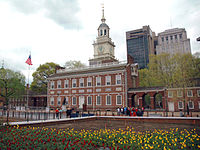United Colonies (1775–1776) United States of America (1776–1781) | |||||||||
|---|---|---|---|---|---|---|---|---|---|
| 1775–1781 | |||||||||
 Thirteen Colonies of North America: Dark Red = New England colonies. Bright Red = Middle Atlantic colonies. Red-brown = Southern colonies | |||||||||
| Status | Unrecognized state | ||||||||
| Capital | Philadelphia (de facto) | ||||||||
| Common languages | English | ||||||||
| Government | Revolutionary confederation | ||||||||
| President of the Continental Congress | |||||||||
• 1775 | Peyton Randolph (first) | ||||||||
• 1779-1781 | Samuel Huntington (last) | ||||||||
| Legislature | Continental Congress | ||||||||
| Historical era | American Revolutionary War | ||||||||
| April 19, 1775 | |||||||||
• Second Continental Congress convenes | May 10, 1775 | ||||||||
| July 2, 1776 | |||||||||
| July 4, 1776 | |||||||||
| March 1, 1781 | |||||||||
| Currency | Continental currency | ||||||||
| |||||||||
| This article is part of a series on the |
| United States Continental Congress |
|---|
 |
| Predecessors |
| First Continental Congress |
| Second Continental Congress |
| Congress of the Confederation |
| Members |
| Related |
|
|
The United Colonies was the name used by the Second Continental Congress in Philadelphia to describe the emerging nation comprising the Thirteen Colonies in 1775 and 1776, before and as independence was declared. Continental currency banknotes displayed the name 'The United Colonies' from May 1775 until February 1777, and the name was being used as a colloquial phrase to refer to the colonies as a whole before the Second Congress met, although the precise place or date of its origin is unknown.
Founding Father John Adams used the phrase "united colonies" as early as February 27, 1775, in a letter entitled "To the Inhabitants of the Colony of Massachusetts-Bay" published in the Boston Gazette:
They have declared our cause their own—that they never will submit to a precedent in any part of the united colonies, by which Parliament may take away Wharves and other lawful estates, or demolish Charters; for if they do, they have a moral certainty that in the course of a few years, every right of Americans will be taken away, and governors and councils, holding at the will of a Minister, will be the only legislatives, in the colonies.[1][2]
On June 19, 1775, the members of the Second Continental Congress called themselves the "delegates of the United Colonies" and appointed George Washington the "General and Commander in chief of the Army of the United Colonies".[3]
On June 7, 1776, Richard Henry Lee, after receiving instructions and wording from the Fifth Virginia Convention, proposed to Congress that they cut their political ties with Britain, declare themselves independent, and create a constitution. Known as the Lee Resolution, and passed by the delegates on July 2, 1776, it referred to the United Colonies, reading in part:
Resolved, that these United Colonies are, and of right ought to be, free and independent States, that they are absolved from all allegiance to the British Crown, and that all political connection between them and the State of Great Britain is, and ought to be, totally dissolved.
Two days later, on July 4, 1776, the 56 delegates to the Second Continental Congress, unanimously adopted the Declaration of Independence, which was overseen by the Committee of Five and written principally by Thomas Jefferson in Philadelphia over a period of two weeks in June 1776.
On September 9, 1776, the Second Continental Congress formally dropped the name "United Colonies of North America" in favor of the "united States of America" in the July Declaration of Independence (later United States of America).
- ^ "Adams Papers Digital Edition - Massachusetts Historical Society". www.masshist.org. Retrieved 2021-08-25.
- ^ ""To the Inhabitants of the Colony of Massachusetts-Bay."". AAS Catalog Record. 1775-01-23. Retrieved 2021-08-25.
- ^ Founders Online, Commission to George Washington, 19 June 1775


